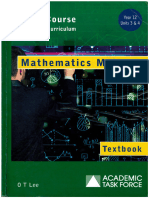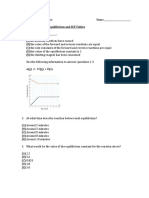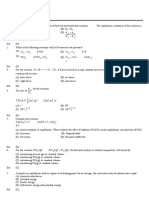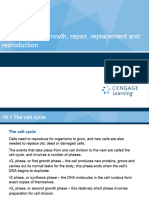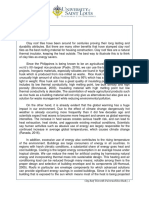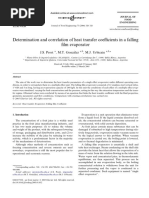Yr 12 Equilibrium
Uploaded by
Ralph Rezin MooreYr 12 Equilibrium
Uploaded by
Ralph Rezin MoorePage 1 of 7
Chapter test
Chapter 1 Equilibrium
Name: _____________________
Class: _____________________
Time permitted: 50 minutes
Number of
Section Marks available Marks achieved
questions
A Multiple choice 15 15
B Short answer 5 15
Total 20 30
Grade: _____________________
Scale:
A+ 29–30 A 26–28 B 23–25 C 19–22 D 15–18 E 9–14 UG 0–8
Comments:
© Cengage Learning Australia Pty Ltd 2015 CHEAC12TT00059 www.nelsonnet.com.au
Page 2 of 7
Section A Multiple choice (15 marks)
Section A consists of 15 questions, each worth one mark. Each question has only one correct
answer. Circle the correct answer. Attempt all questions. Marks will not be deducted for
incorrect answers. You are advised to spend no more than 15 minutes on this section.
1 Which of the following is not a dynamic equilibrium?
A Water evaporating and condensing in a closed bottle of water
B Water evaporating and condensing in an open bottle of water
C A reaction where the concentration of reactants and products is
unchanging
D Two different reactions proceeding at the same rate in the same closed
container
2 Collision theory states a successful reaction can occur when:
A particles collide.
B the reactants are heated strongly.
C the particles collide with sufficient energy to break bonds.
D sufficient energy is released during the reaction.
3 A reaction can be sped up in several ways, including increasing the
temperature, concentration and surface area and introducing a catalyst.
N2(g) + 3H2(g) 2NH3(g) + energy
Which of these would not affect the reaction above?
A Temperature change
B Temperature change and pressure change
C Addition of more reactants
D None of the above
4 What is the correct equilibrium expression for the following reaction?
CaCO3(s) CaO(s) + CO2(g)
B
C [CO2]
D [CaCO3]
5 In an equilibrium reaction:
A all reactants become products.
B products do not form as they quickly return to reactants.
C the amount of reactants and products are the same.
D the rate of forward and reverse reactions are the same.
© Cengage Learning Australia Pty Ltd 2015 CHEAC12TT00059 www.nelsonnet.com.au
Page 3 of 7
6 The equilibrium expression equals [O2] for which of the following reactions?
A O2(l) O2(g) and 3O2(g) 2O3(g)
B O2(l) O2(g)
C 2H2O2(aq) 2H2O(l) + O2(g)
D O2(l) O2(g) and 2H2O2(aq) 2H2O(l) + O2(g)
7 Equilibrium can occur in:
A chemical reactions only.
B physical changes only.
C both chemical and physical changes.
D all chemical reactions.
8 Activation energy:
A determines whether a reaction can be reversible or not.
B only affects the rate of a reaction.
C is unaffected by catalysts.
D of a reverse reaction is the same as the forward reaction at equilibrium.
9 Dynamic equilibrium:
A occurs only at certain temperatures.
B is unaffected by temperature change.
C is when the concentrations of all species are the same.
D occurs when the concentrations of all species is constant.
10 Equilibrium has occurred in which of the following graphs of concentration?
A
© Cengage Learning Australia Pty Ltd 2015 CHEAC12TT00059 www.nelsonnet.com.au
Page 4 of 7
© Cengage Learning Australia Pty Ltd 2015 CHEAC12TT00059 www.nelsonnet.com.au
Page 5 of 7
11 The equilibrium expression, K, is based on the equation below. Which one of
the expressions shown does it equal?
aA + bB cC + dD
D
12 The reaction quotient, Q, equals the equilibrium quotient, K, at equilibrium.
Which of the following is also correct?
A If Q > K, then there are more products than reactants.
B If Q < K, then there are less products than reactants.
C If Q > 1, then there are more reactants than products.
D If K < 1, then there are more products than reactants.
13 Calculate K for the following reaction:
CH3COOH CH3COO– + H+
[CH3COOH] = 0.90 mol L–1
[CH3COO–] = 0.015 mol L–1
[H+] = 0.001 mol L–1
A K = 1.80 × 105
B K = 1.66 × 105
C K = 1.67 × 105
D K = 1.70 × 105
14 What is the correct expression of K for the following reaction?
CH3COOH CH3COO– + H+
© Cengage Learning Australia Pty Ltd 2015 CHEAC12TT00059 www.nelsonnet.com.au
Page 6 of 7
D
15 What is the correct expression(s) for the following reaction?
H2O + H2O H3O+ + OH–
A K = [H3O+]2
B K = [H3O+]2, K = [OH–]2 and K = [H3O+][ OH–]
C
D K = [H3O+][ OH–]
Section B Short answer (15 marks)
Section B consists of five questions. Write your answers in the spaces provided. You are
advised to spend 20 minutes on this section.
1 For the following equilibrium reactions, write out the expression and calculate
the constant stating which side of the reaction is favoured.
a 2SO2(g) + O2(g) 2SO3(g), [SO2] = 1 mol L–1, [O2] = 3 mol L–1, [SO3] =
2.5 mol L–1
b N2(g) + 3H2(g) 2NH3(g), [N2] = 0.4 mol L–1, [H2] = 1.5 mol L–1, [NH3] =
0.03 mol L–1
c 3O2(g) 2O3(g), [O2] = 2 mol L–1, [O3] = 0.5 mol L–1
(2 + 2 + 2 = 6 marks)
Use the following information and illustration to answer Questions 2–5.
Two flasks containing equal amounts of gases in each (hydrogen in one and iodine in the
other) and joined by a glass tube with a valve. The temperature is 330K.
© Cengage Learning Australia Pty Ltd 2015 CHEAC12TT00059 www.nelsonnet.com.au
Page 7 of 7
2 When the valve is opened, the gases mix and reach equilibrium. Describe the
colours of the gases and what observations will be observed.
(3 marks)
3 Write a balanced chemical equation and an equilibrium expression for the
reaction.
(3 marks)
4 How will the equilibrium amount of H2 (g) be affected by the addition of more
I2 (g)?
(1 mark)
5 How will the equilibrium amount of H2 (g) be affected by an increase in
temperature when the enthalpy change for the reaction is +25 kJ mol–1?
(2 marks)
© Cengage Learning Australia Pty Ltd 2015 CHEAC12TT00059 www.nelsonnet.com.au
You might also like
- Biology WA ATAR Units 3 & 4 Student Book With 1 X 26 Month NelsonNetBook Access Code100% (1)Biology WA ATAR Units 3 & 4 Student Book With 1 X 26 Month NelsonNetBook Access Code547 pages
- Methods OT Lee Textbook NOT COMPRESSED (HIGHER QUALITY)No ratings yetMethods OT Lee Textbook NOT COMPRESSED (HIGHER QUALITY)265 pages
- Methods OT Lee Revision Series SOLUTIONSNo ratings yetMethods OT Lee Revision Series SOLUTIONS114 pages
- Topic 7. Equilibrium HL PP Pack, MarkschemeNo ratings yetTopic 7. Equilibrium HL PP Pack, Markscheme17 pages
- How Far The Extent of Chemical Change 74eQ8FrFvsnNMd0pNo ratings yetHow Far The Extent of Chemical Change 74eQ8FrFvsnNMd0p25 pages
- CHEMISTRY EQUILIBRIUM PRACTICE SHEET Maximum Marks_52No ratings yetCHEMISTRY EQUILIBRIUM PRACTICE SHEET Maximum Marks_529 pages
- Which Statement Is True About Chemical Reactions at Equilibrium?No ratings yetWhich Statement Is True About Chemical Reactions at Equilibrium?9 pages
- 60e459fedbb7070071bf2942_##_Chemical Equilibrium _230409_220542No ratings yet60e459fedbb7070071bf2942_##_Chemical Equilibrium _230409_2205426 pages
- 6209f0b7c583d60018c4ba79_##_Equilibrium _ DPP 04 Solution NotesNo ratings yet6209f0b7c583d60018c4ba79_##_Equilibrium _ DPP 04 Solution Notes16 pages
- Equilibrium Practice Exam (Multiple Choice) With Answers PDF100% (1)Equilibrium Practice Exam (Multiple Choice) With Answers PDF8 pages
- Higher Revision Topic 7 (17) EquilibriumNo ratings yetHigher Revision Topic 7 (17) Equilibrium14 pages
- Psi-Ap-Chemistry-Equilibrium-Multiple-Choice 3No ratings yetPsi-Ap-Chemistry-Equilibrium-Multiple-Choice 330 pages
- MC 40: The Effect of Changes in Concentration and Temperature On Chemical EquilibriaNo ratings yetMC 40: The Effect of Changes in Concentration and Temperature On Chemical Equilibria25 pages
- CHEM 123 Chapter - 15 - Chemical - Equilibrium - With - CLNo ratings yetCHEM 123 Chapter - 15 - Chemical - Equilibrium - With - CL108 pages
- Chemistry Units 3 and 4 Practice Questions100% (1)Chemistry Units 3 and 4 Practice Questions51 pages
- Answersheet 2nd Quarter W2 (Chemistry 2)No ratings yetAnswersheet 2nd Quarter W2 (Chemistry 2)4 pages
- CHE 202 Sample MC Questions Equilibrium 1.1 2010-06-07No ratings yetCHE 202 Sample MC Questions Equilibrium 1.1 2010-06-075 pages
- Solved Multiple Choice Questions Chemical EquilibriumNo ratings yetSolved Multiple Choice Questions Chemical Equilibrium16 pages
- 1.8 Chemical Equilibria, Le Chatelier's Principle & Kc 6No ratings yet1.8 Chemical Equilibria, Le Chatelier's Principle & Kc 612 pages
- Practice Test # 1 (Chemistry) SRG 03-10-24No ratings yetPractice Test # 1 (Chemistry) SRG 03-10-246 pages
- College Organic Chemistry Semester II: Practice Questions with Detailed ExplanationsFrom EverandCollege Organic Chemistry Semester II: Practice Questions with Detailed ExplanationsNo ratings yet
- 2023 HBL Unit 1 Exam Booklet One MCQ and Sa100% (1)2023 HBL Unit 1 Exam Booklet One MCQ and Sa27 pages
- Toaz - Info Davies The Trompowsky 2nd Edition PRNo ratings yetToaz - Info Davies The Trompowsky 2nd Edition PR145 pages
- 8 Ex 4C Differentiating X N When N Is NegativeNo ratings yet8 Ex 4C Differentiating X N When N Is Negative12 pages
- Effect of Pulverized Ricce Husk On Clay Roof TilesNo ratings yetEffect of Pulverized Ricce Husk On Clay Roof Tiles27 pages
- Process Modelling Simulation and ControlNo ratings yetProcess Modelling Simulation and Control12 pages
- Chapter 14: Polar Weather: Katabatic WindsNo ratings yetChapter 14: Polar Weather: Katabatic Winds13 pages
- Worksheet: Hooke's Law: Q1.A Student Suspended A Spring From A Laboratory Stand and Then Hung A Weight From TheNo ratings yetWorksheet: Hooke's Law: Q1.A Student Suspended A Spring From A Laboratory Stand and Then Hung A Weight From The11 pages
- Cooling Water Treatment: Product Information0% (1)Cooling Water Treatment: Product Information1 page
- Practice Test I (Basic Science) - SolvedNo ratings yetPractice Test I (Basic Science) - Solved18 pages
- The Use of Calcium Carbonate in Polyolefins Offers Significant Improvement in ProductivityNo ratings yetThe Use of Calcium Carbonate in Polyolefins Offers Significant Improvement in Productivity12 pages
- Selective Dissolution of Austenite in 304 by Bacterial ActivityNo ratings yetSelective Dissolution of Austenite in 304 by Bacterial Activity3 pages
- CE8402 - SOM-II-By WWW - LearnEngineering.in PDFNo ratings yetCE8402 - SOM-II-By WWW - LearnEngineering.in PDF156 pages
- Caisson Design Based On 2021 IBC & 2019 CBCNo ratings yetCaisson Design Based On 2021 IBC & 2019 CBC2 pages
- Electromagnetic Theory, Photons, and Light: OpticsNo ratings yetElectromagnetic Theory, Photons, and Light: Optics29 pages
- Immediate download (Ebook) Tissue Optics: Light Scattering Methods and Instruments for Medical Diagnosis by Valery Tuchin ISBN 9781680157116, 9781628415162, 1680157116, 1628415169 ebooks 2024100% (5)Immediate download (Ebook) Tissue Optics: Light Scattering Methods and Instruments for Medical Diagnosis by Valery Tuchin ISBN 9781680157116, 9781628415162, 1680157116, 1628415169 ebooks 202481 pages
- Determination and Correlation of Heat Transfer Coefficients in A Falling Film Evaporator PDFNo ratings yetDetermination and Correlation of Heat Transfer Coefficients in A Falling Film Evaporator PDF7 pages

